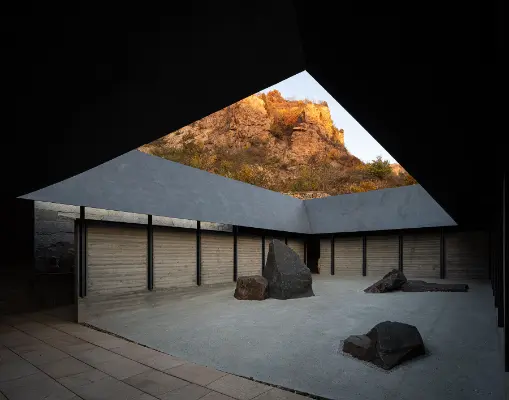阿那亚 · 金山岭上院

下载所需积分: 2
在黎明破晓时,我徘徊在一座古老寺庙的废墟中,
晨光洒在树林的高大树木上。
沿着竹林小径,我来到一个隐秘之地,
深藏在郁郁葱葱的花卉植物中,这里曾是冥想的殿堂。
鸟儿天生喜爱山间的景色,
池塘中,清澈的水面映出一颗净化的心灵。
一切在那一刻都归于寂静,
唯有钟声回荡。
——《一座废墟山寺后冥想室的铭文》,作者:常建 [唐代]
金山岭的上层回廊并不是一座古老的寺庙,而是眼前无尽的古长城,构成了一种前所未有的奇迹。上层回廊的建立为这个山谷设定了一个新的时间节点。
轻盈的冥想厅 “Aranya” 如同踮起脚尖般轻触大地,其纤细轻巧的结构在新建筑与古长城之间拉开了时间的距离,而由于人类的建设,山谷的时间也被重新定位。从上层入口庭院到下层开放的冥想厅,上层回廊本身也努力通过氛围和空间的开合来建立一种内部时间。新建筑不仅在时间和空间上与古长城相互沟通,还与山谷的地形和荒野融为一体。
最终选址的山谷曾用于煤矿开采和梯田耕作。在杂草丛生之下,仍能看到村民们修建的梯田挡土墙的布局,这本身已成为一种地形景观。除了位于下层平台的开放冥想厅,新建的上层回廊依山而建,将1.6米的阶梯地形转化为建筑的空间形式和规模,既是地形也是建筑。
入口围绕着一个开放的石头庭院布置,一侧是供奉佛像的佛教堂。开放的庭院传达出传统走廊庭院的空间氛围,薄钢板向内悬挂,细钢柱附着在混凝土围墙上。开放庭院的向上开口框住了通往天空的视野。从庭院望去,可以看到远处的山脉、烽火台、悬崖和缓缓飘动的云朵。另一方面,西侧面向山谷的水平开口恰好框住了古长城和一座天然石像。佛教堂的名称为“无所不知堂”,意为以普遍知识的智慧解脱烦恼。佛教堂内暴露出自然的山石。
上层回廊内的多个不同规模的内庭院由景观设计师兼僧侣的真名增野 “Shunmyō Masuno” 创作。入口的石头庭院由五块形状各异的自然岩石组成,暗示着佛教文化中的五蕴,即“色、受、想、行、识”,五蕴的结合创造了万物。石头庭院的地面由浅色的凿制混凝土制成。傍晚时分,石头庭院依然明亮,宛如月光下的海洋。五座石峰分为三组,或立或卧,契合了海洋无边无际的概念。这个庭院被命名为“无尽的意义”。
位于山脚的冥想厅由钢结构和碳纤维屋顶构成,形象地重构了汉字“舍”。“舍”字由三部分组成:“亼+屮+口”。“亼”是屋顶,“屮”是梁柱,“口”是基座。内外两圈纤细的钢柱支撑着弯曲的屋顶。方形基座的高度变化适应了山地地形的规模,外圈的钢柱相应调整长度。当人们置身于透明的冥想厅时,山口成为一个真实的围合,唯有面向山谷的方向开阔。古长城不远处,明代的长城是时间的化石。所有的布置都是为了这一刻的宁静。
冥想厅及其周围的深空间被称为“Aranya”,正是“世间的宁静之地,寻找自我的地方”的空间描绘。冥想厅前的池塘映照着山脉和天空,增添了万物的宁静。每当日落或雾气升起,坐在视野中升起的云朵旁,将带来内心的平静。
因此,一系列空间从上到下形成了一个序列,包括石头庭院 “无尽的意义”、佛教堂 “无所不知堂”、冥想室、阅读室、写作室和冥想厅 “Aranya”。所有空间都依附于地形,内外开放与闭合,形成有序的节奏。下方的山谷满是果树和草药,蜿蜒的石径通向古长城。在整理完下院中庭水井和原煤矿景观后,金山岭上层回廊将完工。
At the break of dawn I wandered in the ruins of an ancient temple,
On lofty trees of the woods the morning sun cast its rays.
Following a path amongst bamboos I came to a secluded place,
Hidden deep amidst lush flowery vegetation, it used to be a chamber for meditation.
Birds by nature took delight in mountain scenes,
In the pond, a mind cleansed by the waters a lucid reflection made.
Everything gave way to silence right there and then,
Save for the tolling of bells that resonates.
An Inscription for the Rear Meditation Chamber of a Mountain Temple in Ruins, by CHANG Jian [Tang Dynasty]
The Upper-Cloister in Jinshan Mountain is not an ancient temple, but the ancient Great Wall as far as the eye can see is an unprecedented miracle. The establishment of the upper-cloister has set a new point-in-time for the valley.
A light meditation hall (Aranya) touches the ground on tiptoe, as its slim and light structure sets the distance in time between the new construction and the ancient Great Wall, and the valley has also been relocated in time due to the human construction. From the upper entrance courtyard to the lower open meditation hall, the upper cloister itself also strives to establish an internal time through atmosphere and the opening and closing of space. The new construction not only communicates with the ancient Great Wall in time and space, but also fits into the topography and wilderness of the valley.
The valley where the final site was selected had been developed for both coal mining and terrace farming. Under the weeds, one can still see the arrangement of the terrace retaining walls built by the villagers, which has become a topographical landscape in itself. In addition to the open meditation hall on the lower platform, the new upper cloister is built against the mountain slope, and translates the 1.6-meter stepped landscape terrain into the spatial form and scale of the building. It is both terrain and architecture.
The entrance is arranged around an open stone courtyard, with a Buddhist hall to house Buddha statues on one side. The open courtyard conveys the spatial atmosphere of the traditional corridor courtyard with the thin steel plates hanging inward and the thin steel columns attached to the concrete enclosure wall. The upward opening of the open courtyard frames a view towards the sky. Looking from the courtyard there are distant mountains, beacon towers, cliffs, and clouds cruising slowly in the sky. On the other hand, the horizontal opening facing the valley on the west side precisely frames the ancient Great Wall and a natural stone statue. The name of the Buddhist hall is "Omniscience Hall", which means to free oneself from troubles with the wisdom of universal knowledge. Natural mountain rocks are exposed in the Buddhist hall.
The several inner gardens of various scales within the upper cloister were created by Shunmyō Masuno, who is both a landscape architect and a monk. The stone courtyard at the entrance is composed of five natural rocks of different shapes, implying the five aggregates of clinging in Buddhist culture, namely "form, sensation, perception, activity, and consciousness", and the combination of the five aggregates creates all things. The ground of the stone courtyard is made of light-colored chiseled concrete. In the evening, the stone courtyard is still bright, just as the sea under moonlight. The five stone peaks are divided into three groups, standing or lying, which coincide with notion that the sea is boundless and endless. This courtyard is named "Endless Meaning". .
The meditation hall made of steel structure and carbon fiber roof at the foot of the mountain is a pictographic reconstruction of the Chinese character "舍". The character "舍" is composed of three parts: "亼+屮+口". "亼" is the roof, "屮" is the beam and column, and "口" is the base. Two rings of slender steel columns inside and outside support the curved roof. The changing height of the square base adapts to the mountain terrain in terms of scale, and the steel columns on the outer ring adjust in length accordingly. When people are in the transparent meditation hall, the mountain pass becomes a real enclosure, and only the direction facing the valley is open enough. Not far away, the Great Wall of the Ming Dynasty is a fossil of time. All the arrangements are for this moment of tranquility.
The meditation hall and its surrounding deep space named "Aranya" is exactly the spatial portrayal of the term’s original intention of "a quiet place in the world, a place to find the self". The pool in front of the meditation hall reflects the mountains and the sky, adding to the tranquility of everything. Whenever the sun sets or the fog ascends, sitting down with rising clouds in sight will bring peace to the mind.
Therefore, a series of spaces form a sequence from top to bottom, including the stone courtyard (Endless Meaning), Buddhist hall (Omniscience Hall), meditation room, reading room, writing room, and meditation hall (Aranya). All are attached to the terrain, open and close inside and outside, forming an orderly rhythm. The valley below is full of fruit trees and herbs, with winding stone paths leading to the ancient Great Wall. After the Xiayuan Zhongting water well and the original coal mine landscape are sorted out, Jinshanling Upper Cloister will be completed.
CREDITS
Design Team: Liu Yichun, Shen Wen, Chan Hio Ngai, Wang Longhai, Gong Yu, Zhang Xiaoqi, Wang Yi, Sun Huizhong, Ji Hongliang, Zhang Zhun (structure), Zhang Chongchong (structure)
Structure Consultant: AND Office
Structure and M&E: Beijing Yanhuang International Architecture&Engineering Co., Ltd
Landscape consultant: Shunmyo Masuno + Japan Landscape Consultants (courtyards and gardens), Turenscape (environment) Statue of Buddha:The Jiangs
Lighting consultant: Zhongchenyuanzhan Lighting Design Co., Ltd,DLX Lighting Design